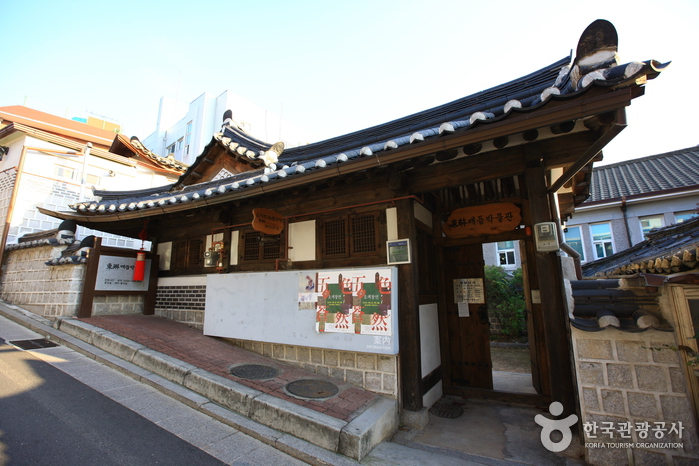Yeonwoohouse [Korea Quality] / 연우하우스 [한국관광 품질인증]
5.0Km 2023-09-12
5-13 , Bukchon-ro 12-gil, Jongno-gu, Seoul
+82-2-742-1115
Yeonoo House is a quiet and cozy traditional hanok in Bukchon Hanok Village, Jongno, Seoul. There are two small rooms, each with its own bathroom. Residents can access a superb panoramic view of Bukchon Hanok Village by mounting a ladder up to the roof. As Yeonoo is an old building, careful attention is paid to hygiene management. Gyeongbokgung Palace, Cheonggyeonggung Palace, and Changdeokgung Palace are all nearby.
Donggwol Maru - Korea Cultural Heritage Foundation Branch [Tax Refund Shop] (한국문화재재단 동궐마루)
5.0Km 2024-10-15
99, Yulgok-ro, Jongno-gu, Seoul
-
Seoureseo Duljjaero Jalhaneunjip (서울서둘째로잘하는집)
5.1Km 2024-03-15
122-1 Samcheong-ro, Jongno-gu, Seoul
+82-2-734-5302
Seoureseo Duljjaero Jalhaneunjip is a sweet red bean porridge and traditional tea house near Gyeongbokgung Palace. Sweet red bean porridge is a sweet and smooth dish typically containing chewy rice cakes and chestnuts. In Korea, it's a traditional food eaten during dongji (the shortest day and longest night of the year). They also offer traditional teas like ssanghwatang (herbal tonic tea), which contains seven medicinal herbs, sujeonggwa (cinnamon punch) with a blend of cinnamon and ginger flavors, and sikhye (sweet rice punch), a drink known for aiding digestion.
Saemaeul Sikdang Dongdaemun (새마을식당 동대문)
5.1Km 2024-03-11
1FL, 30, Eulji-ro 43-gil, Jung-gu, Seoul
+82-2-2274-0410
Located near Dongdaemun and Dongdaemun Design Plaza (DDP), Saemaeul Sikdang specializes in traditional Korean grilled pork, including bulgogi, moksal (grilled pork shoulder), and grilled intestine. Especially for lunch, patrons have the option to delectable baekban (hand-made set menu), which is a traditional home-made Korean meal with steamed rice and grilled pork for side dish.
Tonymoly - Dongdaemun Branch [Tax Refund Shop] (토니모리 동대문)
5.1Km 2024-04-18
257, Jangchungdan-ro, Jung-gu, Seoul
-
Dong-Lim Knot Museum (동림매듭박물관)
5.1Km 2021-12-21
10, Bukchon-ro 12-gil, Jongno-gu, Seoul
+82-2-3673-2778
Opened in April 2004, Dong-Lim Knot Museum exhibits a variety of decorative traditional Korean maedeup (knots): norigae for hanbok, belts, pouches, as well as materials like thread, cord, and accessories. Housed in a hanok, a traditional Korean house, the gallery has a variety of exhibits, including old and new artwork, and creations that reflect modern trends.
Dongdaemun History & Culture Park (동대문역사문화공원)
5.1Km 2024-11-27
281 Eulji-ro, Jung-gu, Seoul
Dongdaemun History & Culture Park is a park established on the former site of the Dongdaemun Stadium. It serves as a thematic park showcasing the history and culture of Seoul, while also providing a space to experience modern design and culture. During the park's development in 2008, numerous artifacts from the Joseon dynasty, including The Two Floodgates, the Chiseong Castle, Military Training Agency, and over 1,000 relics from the Joseon era, were excavated. Alongside the park, there is the Dongdaemun Design Plaza (DDP) and the Relic area.
Dokkaebi Bulgogi (도깨비불고기)
5.1Km 2024-03-12
38 Eulji-ro 43-gil, Jung-gu, Seoul
+82-2-2269-1538
Dokkaebi Bulgogi is a Korean restaurant located near Dongdaemun Design Plaza (DDP), Cheonggyecheon Stream, and Dongdaemun Gate. Its main menu features Korean-style barbecue made with beef and pork. In addition to dishes like galbi jjim (braised galbi) and pajeon (green onion pancake), they also offer simpler options such as galbitang (galbi soup), jjigae (stew), and naengmyeon (cold buckwheat noodles).
Sunmine Haengbok Gejang Dongdaemun (순미네행복게장 동대문)
5.1Km 2024-03-12
3FL, 38, Eulji-ro, 43-gil, Jung-gu, Seoul
+82-2-2268-2059
Sunmine Haengbok Gejang is exclusively dedicated to Korean-style kkotgejang (soy sauce marinated blue crab) and shrimp dishes. Gejang is a Korean favorite dish made by marinating blue crabs in soy sauce and other seasonings. The restaurant offers also saeu jang (soy sauce marinated shrimp) and fried shrimp. In addition, one can exlpore Dongdaemun and Dongdaemun Design Plaza (DDP) nearby, enriching the cultural experience.
Bukchon Museum (북촌생활사박물관)
5.1Km 2022-08-30
90, Bukchon-ro 5na-gil, Jongno-gu, Seoul
+82-2-736-3957
The Bukchon Museum displays items that have been collected from Bukchon, a historical village that was once home to the nation’s nobility. The museum was founded to observe urban development that took place in the recent decades through collected and preserved veryday household items that were used by Bukchon residents. Visitors are even allowed to touch items on display to better be able to imagine life in Korea before industrialization.
![Yeonwoohouse [Korea Quality] / 연우하우스 [한국관광 품질인증]](http://tong.visitkorea.or.kr/cms/resource/52/3009452_image2_1.jpg)



 English
English
 한국어
한국어 日本語
日本語 中文(简体)
中文(简体) Deutsch
Deutsch Français
Français Español
Español Русский
Русский